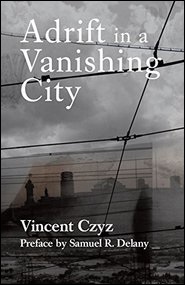about the author
Staff Book Reviewer Spencer Dew is the author of the novel Here Is How It Happens (Ampersand Books, 2013), the short story collection Songs of Insurgency (Vagabond Press, 2008), the chapbook Mont-Saint-Michel and Chartres (Another New Calligraphy, 2010), and the critical study Learning for Revolution: The Work of Kathy Acker (San Diego State University Press, 2011). His Web site is spencerdew.com.
To send your new book to decomP for possible review, see our guidelines. To find out what’s currently under consideration, visit our review queue.
∧
font size
∨

A Review of Adrift in a Vanishing City
by Vincent Czyz
Spencer Dew
An Afterword makes clear that many of the characters encountered in this book “closely resemble persons both living and dead,” an inversion of the well-worn loosely legal but often also dissembling language at the start of so many novels. Czyz wants us to know, wants us to part ways with his book remembering: there is reality here. Character, however, is less immediate here than place, or, rather, the characters, flâneurs, lend us their eyes and their perspective but the focus—theirs and ours—remains place. These places may blur, may become abstract at the edges, interchangeable and yet simultaneously marked by particularity, like the settings of dreams, but that experience of being in and travelling through them is the experience of this book, the feel of wandering “deserted streets, cities even continents apart always the same near dawn,” architectural silhouettes casting shadows on paving stones as one explores the plazas and canyons, nooks and undercrofts of the urban.
Those real people, living and dead, who went into this book play the role now of guide, of companion. One wanders, as reader, but on these “insomniac walks” one is never alone. The reader is less an I or a you than part of an intimate we:
We refused to go home, dragging a bottle of wine by the neck, winding up under the lion-guarded bridge whose lamps cast over it a faded green, using the long pea coat I picked up at a pawn shop in South Dakota to cover the cold asphalt. You taught me that prayer is more than whispered demands and hands pressed together, that it requires more than one person.
Likewise, the flâneurship Czyz celebrates requires more than one person, involves the boisterous conversation, the comradery of close talk, the intoxication of proximity if not also some other kind. When we end up at that café in Montmarte “insides warmed with clam soup and escargot, fingers shiny with garlic butter, arguing with three old men about Foucault and Hamlet and Kafka,” the talk ricochets in multiple directions and as many languages. The babel becomes a kind of pun, word play, the organic hiss of “yes” in three Romance tongues. And personages, when not present, as missed with a nostalgia rooted in the specifics of place: “What bridge in what part of the world on what locust street in Pittsburg, Kansas . . . is he leaning against a building boarded up since Prohibition and wishing for a yeast-clouded beer in a Berlin café where we will be close enough to exchange nightmares?”
The line about prayer, however, has another valence for this project. Prayer, as ritual act, communal, self-searching and laced with desire, is an apt metaphor for thinking about this work. One contemplates history, consciousness. As Walter Benjamin knew, the flâneur is always also something of an archeologist, wandering through layers of time, traces. Czyz has a voice say, “Buildins gone, bricks left, blueprints an’ history remain. One Berlin exists only in imagination, the mythic realm a the Hopi on their mesas overlookin the fallin a time like slow dry rain on an earth eroding in desert wind.” Likewise, “to stand and gawk” is also to “reel with déjà vu,” to experience that which requires some theory—of self or species, perception or being, time or eternity. In lieu of postcards, the traveler collects impressions, emotional moments, framed by Czyz in aphorisms, poems like fragments of colored glass glinting, gem-like from the sidewalk: “No straight edges, Mexico is a country without reliable geometry” or “Ma buried the placenta and umbilical cord underneath the welcome mat to make sure, like the Navajo do, that he’d come home.”
And perhaps that is most what this act of exchange, of togetherness, that constitutes Czyz’s shoe leather prayer is ultimately about, coming home as a kind of return to the circle of conversation, whether in Budapest or Paris, Texas, a return to the table and the talk. Rather than the dwarfing alienation of some huge stone cathedral, here is the winking pop of Chianti corks and laughter and conversation, “talking about chiaroscuro those words he brings back from his trips no one’s ever heard . . . the last light of the fields a halo around the bottle...” Whether prayer or not, that is the sort of pleasure brought to and imparted from these pages. A kind of benediction, like the sound of screen doors or moth wings, the feel of a lover’s hands mid-love-making, the smell of a proper red sauce being slowly stewed. To a book so thick with such things, I can only say, Amen.
Official Vincent Czyz Web Site
Official Rain Mountain Press Web Site